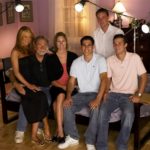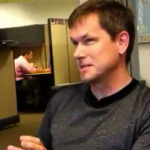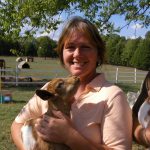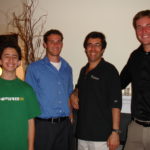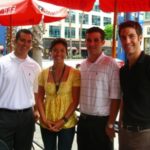John Powers, founder of the Alliance for Sustainable Colorado, recognizes the extent to which Earth is in danger. Fear of overwhelming odds, however, does not imbue, in John, the apathy, towards natures, so prevalent in American society. In an age where Green Building has become a talking point in American politics, John is doing, and has done, a lot more than talking. The Alliance’s largest accomplishment, a renovated warehouse built in 1907, lies 18 blocks from the state capitol in downtown Denver, and houses numerous non-profits that share John’s commitment to green business.
The building is a symbol of more than John’s commitment to the environment. It is the permanent home of many non-profits, groups that often notoriously lack the financial stability to inhabit quality office space. In giving these groups a place, and a place to be proud of, John has also inspired a sense of community. This community, or alliance, works to eliminate the concept of special interests, hoping to place a larger scale environmental movement in everyone’s interest. Having been inspired by the strong sense of heritage in European communities, John hopes to instill, in his community, the same reverence for the past, in hopes of inspiring expectation and hope for the future. “You gotta protect this stuff,” John says of Earth’s natural resources, “Not because it’s worth money, but because it lets us live.”
Interview
What is Alliance For Sustainable Colorado?
Alliance for Sustainable Colorado was created to facilitate collaboration among the individuals and the sectors of non profit business, government, and academia to get people working together to develop policies and implement practices of sustainability.
I think that the size of problems, take global warming, or just about anything you can think of- population, resource consumption- problems are caused one person at a time, and they’re going to have to be solved one person at a time. We can’t sit around and let someone else do it. We can’t exclude any groups.
When enviros try to take a piece out of business, it’s not going to work. If business won’t talk to enviros, it’s not going to work. Everybody, I think we’re in such dire straits right now that our purpose is to make sure that people who do work together work well together.
When did you found this, and why?
I started it unofficially in 2003 by creating the Colorado Alliance for Sustainable Business Associations. I’ve been involved in the non profit realm through foundations that did funding to environmental groups. I introduced the environmental grant making program to that foundation and started to realize that the problems are so big that it has to have all of us working on it.
First point is to create a means to communicate. We create a directory of sustainable businesses associations. From there, you do events together. We do that cross sectoral. The people become familiar with each other, build relationships, and are more willing to work together. Finally, you have some common project on which they work together, and that what cements the whole thing.
We were trying to make, a guess the sound bite would be, a fabric that won’t tear. Because if there’s one thing I think we need to do, I think it’s to unify. I think that by being fragmented, by being called special interest, by not working together, I think that’s a main contributing factor to why we are in the mess we’re in.
You’re talking about forming an alliance. With this building you’ve had 28, 30 non profits that have joined?
I think a sense of place is very strong. Very important. A lot of writers write about that. You look at a ediphus of almost anything, and you see it’s a large corporation. You take non profit groups that can be insecure in their fundraising, insecure in having quality space to work in, and it’s not a fair way to collaborate as equals. Having a place and creating what we’re working on, a state sustainability movement. That it has a place where people can come and work together. I think that having that place is important.
We chose this location because it happens to be eighteen blocks to the state capital. Our model for the Alliance of Sustainable Colorado could be an alliance for any state. We’re trying to do ours first with two elements. One would be the collaborative among the sectors. And the second is having a place to do it. In the state capital.
We chose this building. We renovated it. It’s a 1907 built warehouse in the historic district. We went through it, and now have two certifications under the U.S. Green Building Council LEED program. Leadership and Energy in Environmental Design. One of two buildings in the world.
Not only is it to walk the talk. Not only is it to provide quality, low cost, stable secure space. But we’ve got the two certifications so it would attract interest. That way, people from the outside who want to come see the building will see all the groups in it. It’s a way to draw attention to a state based sustainability movement.
It’s interesting. What kind of renovations did you do when you first got here?
On this floor, the second floor, we gutted it. It used to have the corporate offices for the bookstore which is a couple doors away. You can see here that there’s a penetration through the wall. The different floor plates, the different heights. There’s a long tongue of a ramp that came out. It really was just dysfunctional. So we gutted this floor and turned it into offices. The first floor was wide open. It was shipping and receiving for the bookstore. We started over with it and turned it into offices. The third we finished out. The fourth and fifth floor we didn’t do much.
But the paint, we did renovations in the lights, we have lower energy consuming lights and higher quality. They’re more like daylight. We have a 2.56 year payback after having renovated the building. We renovated the water fixtures. We cut our water use by 84%.
Z: Just with fixtures?
We changed 3 gallon flush toilets to 1.0 gallon flush. 1.0 flush urinals to zero. They don’t use water. We put flow restrictors on all of the facets and the showerheads. And we cut our water use 84%. Our water bill, 78%. And we have about a 4.6 year payback on retail prices for the renovation.
Buildings did this city wide. But that’s the problem. The problem is we lack federal leadership. With the federal absence of leadership, there’s a certain political football played. They take some of the decisions and they send them down to the states. They send them to the states when they think they’re going to get what they want. They’ll keep them at the federal level if they think they’re going to get what they want.
The goal of having a state based sustainability movement is having all sectors of society, all the affected people, the citizens of Colorado, working together. So in those cases when the federal government puts decision making authority down to the state level, the state will work cooperatively, taking all points of view in. You’re going to have a better decision made taking all points of view and you’re going to have more buy in. Those people who participate in making the decisions will certainly be more apt to support their implementation. That’s sort of the theory.
It seems like a lot of work. Why do you care so much about all this?
Interestingly enough, I had the chance to live in Europe a couple times. You can back to a European town many years later, and you can find the same person that you knew, living in the same place many years later. That’s unheard of in this country.
We don’t have roots. We don’t have a sense of depth. We don’t have a sense of past. We don’t, therefore, easily look forward. Because we don’t consider time as much as we’re focusing on right now. I think part of the by product is our sense of community is much diminished by comparison to other older countries. We’re a young country, relatively.
This is creating a sense of community. It’s a total joy. I love coming to work here. I love being around people I like who are working on issues I care about. I love helping them get their work done. We made it dog friendly. It’s just a fun place to be with great people who care about each other.
It’s like creating, in a sense, a permanent party. But you’re doing something productive. It’s not like going to bar, it’s like going to build and paint a fence together. I get to know you better, and we’re doing something productive at the same time. It has a strong social component of fulfillment, reward, and accomplishment. It’s just fun.
The idea that we can do this in other states and attract more people. I mean, you folks are here. It’s attracting attention, it’s attracting interest. It’s getting the word out there. We have to work together or we’re toast.
How is having all these people around affected your work? Along with the success you’re experiencing here.
Since we’re working multiple sectors, businesses, government, both the federal delegation, who we’ve gotten to know quite well. Mark Udal, Diana Deget, Ed Pearlmutter, Senator Salazar have been through the building. Governer Ridder is coming in a couple weeks. The President of the Senate and State Legislature. The Majority Leader of the Senate. We actually worked with the Majority Leader of the Senate, Ken Gordon, on getting a bill passed. It took us three years.
That’s actually a very good example. We did a briefing. This is on the willingness, the means, and the reason of having us all work together. Means is the directory we created of sustainable business associations. We created that directory so people could communicate. Then we held an event. It was a briefing by leaders of both houses and both parties to tell the sustainable business associations and non profits and individuals what kind of legislation they might anticipate that would affect their interests going forward. Out of that briefing, we got the majority leader of the Senate to carry a bill to require all state funded buildings to be green. It took us three years to get it passed, and we did. It was a perfect example though of the means, the willingness to get people together, and the reason of getting people together. Because when we worked on getting that bill passed, we used the American Institute of Architects Committee in the environment. We had people testify and educate the legistlators.
The U.S. Green Building Council of Colorado Chapter people helped us. We had engineers and architects. We had university professors. We had students from their classes come in and testify. We had the lobbyists from the non profit groups train them on how to make their presentations. That was a perfect example of individuals, non profits, business, and government, and academia, working together on an issue that benefits all of us. It’s public interest movement.
What’s your ultimate goal with this? Do you see yourself working in this forever? What’s your ultimate goal if you could have it?
I have two personal goals. They’re somewhat out of the extension of the organization. The organization has it’s own life. But one goal is we want to build a new building alongside this one in the parking lot that we own. It came with the purchase of this building. And create a national center of state bases of sustainability movements. A place where they can meet. Denver is as close to the center of the country with good access by airport as any closest city with the shortest travel. Most, least, damaging.
That would create space for a greater number and a greater diversity of a group for a universal event space where people could build their relationships and exchange the ideas and best practices. Develop campaigns, share strategies from around the country. And to start to have this built out. This fabric that won’t tear.
The first goal is to get that building built. Do it with new construction using the highest standard we could achieve, which would be platinum, if we could pull it off. We have a $15 million capital campaign that we’ve got to get through before that’s going to happen. We want to raise the money before we start to build it because we don’t want to jepordize the tenants who are here with any kind of financial insecurity for that. We have a mortgage on this building. We have to keep the bank happy.
That would be one goal, the new building. The second thing is the unsustainable challenge to Colorado is the constitutional amendment that passed in the early 90’s called TAVER. The taxpayers bill of rights. Which is diabolical. It’s intended to squeeze government out of existence. I can go through the machinations of that works, but it constrains the budget of the state and as a consequence, our roads are crumbling, our schools are falling apart, our healthcare for kids, our insurance for kids- it’s all designed to put government out of business. And there are very valuable government services.
None of us want an overly large government. We want an effective and efficient government. Killing government does not make it efficient or effective. It kills it. TAVER is the most unsustainable challenge that’s confronting the state of Colorado.
Other states have seen what’s happened to Colorado and they won’t touch it. Other states have been introduced to it and no one’s bought it. Now we have to get it out of this state. Those are the two major long term goals.
So Janna Six, she said she’s worked with you for twenty years. She said you are the most passionate person she knows. I was going to ask you why you thought she would say that.
I’m having fun. I do what I believe in. I try to provide other people with the opportunities to have fun. I try to make it contagious. I try to persuade other people that we have to work together and get on the ball.
It was fun, a couple nights ago I came up with a term that I’m going to start using. Live as though you love life. What is life? Life is each other. Life is the other elements of the planet’s ability to support life. Plants, trees, even worms, birds, you name it. All the life forms. Live as though you love life more than you love things and possessions. That’s what we need to start doing. It’s really fun when you do that.
I’m passionate about it because I’m highly rewarded. I’ve never had so much fun. I think other people around here are having fun. We’re working together on something productive that matters. It’s a joy. Maybe I exude it.
If you could go back to when you were our age at 22 years old and just tell yourself one single piece of advice, what would you say?
Live your dreams, not your fears. So many people in personal relationships ask themselves, ‘What if she won’t go out with me?’ What if. What if, what if! It’s like putting energy in a knot. Let’s see if we can’t find a good parking place. What happens if you succeed? You succeed if you didn’t find it. Let’s see if we can’t find a parking place? No. We have to change the mindset. Let’s see if we can find a parking place. Let’s see if we put our energies into doing something, not putting our energies into not.
So when you live your dream, you live your hopes, put your energy into what you want to see come out. Don’t be constrained by those things that may not work out. Don’t have your spirit dampened by telling yourself it may not happen. Picture what you want and go for it.
And that’s what you’re doing right now.
Yeah. It’s fun. It’s so darn much fun.
Do a lot of people tell you ‘no?’ Do you get a lot of people who tell you ‘no’ and a lot of static when you’re trying to push forward with your ideas?
At first, there’s always the, ‘You think you’re going to pull that off? You’re going to buy a $4.5 million building?’ We got the chance to buy the building in February of 2004. Then we filed our non profit papers. Then it was a race. Which was going to happen? Would we close first? Or would we be a non profit first?
By design, I want the building to be owned by the public domain. I want it to be owned as a non profit. Because I want this to endure. If it were private investors, I step off a curb and I’m hit by a bus and my heirs say that I have a good asset. ‘The areas improved. We’ve got these non profit tenants who aren’t paying market rent. We could charge market and do great!’
So I put it in the public domain because that can’t happen now. It’s a long term plan on making it secure. So when started, it was critical that we have, in my view, our public charity status. Our 501 c3 status. When we got going, we signed the contract in February. We filed our papers in March. We got our IRS designation June 18th. We’ve got the building June 30th.
Like I said, there were a lot of changes of underwear during the middle of June because I didn’t know what was going to happen if we came to closing and we didn’t have our 501 c3 status.
Z: So which of the non profits actually owns the building?
The Alliance for Sustainable Colorado. It’s a legal thing. We formed an LLC. There’s the Alliance Center Legal Liability Corporation. Its wholly owned, wholly operated by the ASC. Typically, someone would trip on the ice if they went after you. They can only go after the building. They can’t go after anyone else personally or the alliance or whatever. It’s a legal protection.
B: What should we check out around here?
There’s two elements. Two things going on in the building. One are the green features. Two are the organizations in the building. It happens that among the features, there are certain things by design. We’re in a conference room on this floor. There’s a conference room on the 3rd floor. There’s a conference room in the basement. 4th floor, and the two tenants on the 5th each have their own conference areas to share.
We could have turned this into office space. We could have gotten more revenues that way. But no, this is a collaborative feature. You’ll downstairs where we put in a mailbox. All the tenants share. We discontinued individual mail delivery to each office because that way, tenants are going to bump into each other.
We put in a little lunch room downstairs. Same thing. People bump into each other. We also make these rooms available to people outside the building. So non tenants can come in and we charge a nominal fee because it’s not fair to the tenants who are paying rent and it’s part of their rent.
We have a LCD projector in two of the rooms. If you were to rent that individually, it might cost you anywhere from $75-$100. That’s included. For $25 an hour we charge people from outside the building. So there’s the green features, there’s the collaborative features, and that’s a segway to the groups that are in the building. They’re the synergistic results of being so close together and being able to share work and being more efficient and effective.
You’ll see in the Southern Rockies Eco Project down the hall a gigantic printer. I don’t know if you’re familiar with a plotter, where the plotter was the last generation. You had a printer and a plotter for doing blueprints and GIS. The current generation has a giant printer. The plotters are now obsolete. There’s one plotter and they’re part of a thing called Southern Rockies Conservation Alliance. 26 organizations working on wilderness, both for BLM and forest. These 26 groups tend to parcel out the

